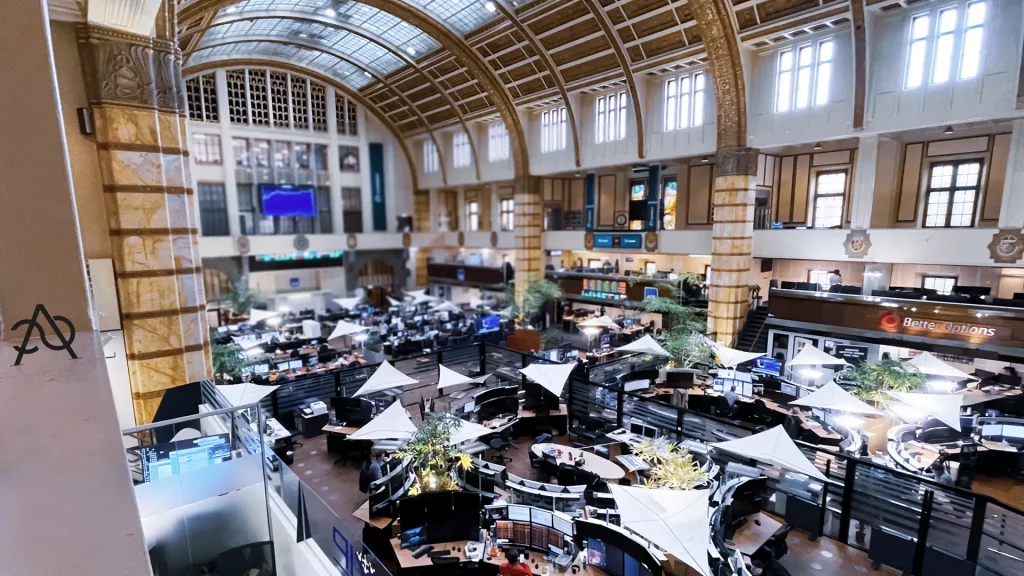Corporate HQ Amsterdam, the Netherlands

On May 1, 2022, we established our corporate seat at the Amsterdam Stock Exchange in the Euronext building, the financial heart of the Netherlands. This place is not just any place. It’s The birthplace of the current banking system and the city where the world’s first stock ever issued; the share of the VOC.
The birth of banking

In the early modern Netherlands, the “gulden” was the currency, but there was not a single standardized gulden-coin. Around 1600 there were between eight hundred and one thousand different coins in circulation. This currency chaos resulted in a chaotic situation that was exacerbated by the steady devaluation of the coins. And so the Wisselbank was founded in Amsterdam in 1609. Merchants could open an account with the Wisselbank, which was located in the town hall on Dam Square.
However, it took a long time for that stabilization to take place. The main reason for this was that many payments were made outside the bank. Small amounts were of course mainly paid in cash, but for larger amounts many merchants preferred the services of cashiers to that of the Wisselbank. Cashiers were already active in Amsterdam before the Wisselbank was established. With them it was possible to transfer money; they kept bills from their various customers. If a trader did not want to be paid by bank, but wanted to have cash in his pocket, he was given an assignment. Such an order could be exchanged for coins, similar to checks.
Since 1683 it was possible to lend precious metals to the bank. This meant that account holders brought precious metals to the bank, for which they received a receipt. After six months they got their bullion back or the loan could be extended. Merchants could then trade or make payments with the receipts. This service from the Wisselbank led to a massive influx of precious metals into Amsterdam, enabling the city to become Europe’s most important trading center for precious metals. It also significantly increasing the circulation (velocity) of the gulden.
At the same time, the issuance of receipts ensured that account holders never had to deposit money again. After all, the right to a deposit could be traded. If a merchant needed cash, he could get it more easily by selling his receipt than by withdrawing his balance from the bank, for which the bank charged. On Dam Square, in front of the town hall, a lively trade in recipes took place every day. The cashiers, who controlled this trade, thus took the place of the Wisselbank’s counter.
With deposits no longer being taken in practice, bank money was de facto disconnected from the current money outside the bank. A currency had emerged that existed only on the bank’s books. The practical advantages this entailed for large transactions ensured that Amsterdam became the center of international payment traffic: governments and wealthy foreign merchants paid via Amsterdam. But the decoupling of bank money offered even more advantages: it enabled the Wisselbank to conduct an active monetary policy. By increasing or decreasing the issuance of receipts, the Commissioners of the Exchange Bank were able to influence the size of the money supply in the Republic. It was the first time in history that a bank was involved; nowadays this is one of the main tasks of central banks.

And trust in the bank?
This was based on a guarantee that the bank would pay out full-fledged coins
and an almost complete coverage of deposits by precious metal.
However, as the years went by, they took more and more risks by lending/investing these funds
in promising ventures such as the VOC,
speculating on high returns…
The birth of stock trading
Founded in 1602, the “Generale Vereenichde geoctrooieerde Compagnie” or in contemporary colloquial language “Verenigde Oost-Indische Compagnie”, was the first company in the world to issue shares to a broad public. Before the emergence of the VOC, a limited circle of moneylenders could already participate in financing a single sea voyage. If it was successful, the investors shared in the profit, but if the trip failed, they lost their money. With the VOC, investors from all walks of life were able to invest for the first time in a company that intended to last for many years and that already had many characteristics of a modern public limited company.

The trade in VOC shares took off. With the first issue, the VOC raised 3.3 million “daalders” and the company subsequently grew into the first multinational in the world. By 1606 the shares had already increased in value by 200%; in 1610 the company paid a dividend for the first time. Fairly soon after the first ‘IPO’, trading was lively and Amsterdam developed into the cradle of global stock trading.
The issuance of tradable shares was a revolutionary development for the 17th century. Investors could sell their securities and then get their money back, while the amount of participation still remained in the company. The VOC literally succeeded in turning 1 daalder (the currency from which the dollar gets its name) into 2 daalders. The golden age. It is no wonder that other companies at home and abroad soon followed suit. Governments also discovered the benefits of the public capital market.
However, in that eighteenth century, annual dividends of 12.5% or even more were still paid. Unfortunately, at this time the cash was almost empty due to excessive spending and increasingly expensive trade trips: there was no longer any relationship between the profit and the payment of dividend. In a sense, the VOC contributed, in that zeitgeist, to the distribution of wealth and to making it available to ordinary citizens. However, this manifested itself many years later, unintentionally or not, in a skewed distribution of that same wealth.
Even more ironically, it turned out that the Wisselbank had provided large (illegal) and very risky loans to the ailing VOC and city of Amsterdam. Together with an already weakened economy and many bankruptcies of Amsterdam companies, confidence in the bank had completely disappeared. The VOC existed for almost 200 years. In 1799 it was effectively disbanded. The worldwide popularity of IPOs and unfortunately also the skewed distribution of wealth since then means that the VOC is in a sense still very much alive!
400 years later, nanoseconds faster

Back then, stock trading and settlement took multiple days, especially between different exchanges in the world. The transfer of ownership of securities was done manually; the seller had to deliver the stock certificate by mail or in person to the broker representing the buyer. The buyer would not pay the security until the share certificate was received.
It is a strange but wonderful sensation that more than 400 years later this market has evolved into a global equity market where the difference can be made at the nanosecond via complex worldwide digital infrastructures, protocols, and technologies. Enabling Masternode.one to deal with the latest market developments and instruments; providing order book and pool liquidity for digital, decentralized and tokenized assets 24/7 globally in nanoseconds. We believe that we are in the eve the next step in the evolution of trading instruments; the (decentralized) tokenization of stocks is. And it is precisely this that offers us an opportunity to redistribute this wealth across the globe more equitably and thereby giving everyone access to this prosperity and wealth through an alternative decentralized, permissionless, transparant, financial infrastructure.
While Amsterdam offers us the creative energy of Dutch entrepreneurship,
Euronext offers us the security of a hi-tech, transparent, and regulated environment
for professional trading while making markets stronger and more efficient
in competition with other ‘cashiers’ in giving the best quote price
for an asset on modern, open digitized and decentralized ‘Wisselbanken’.
